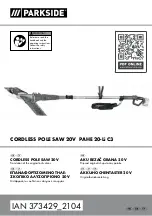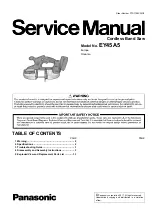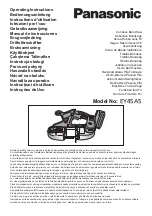
41
41
Operation
Plain sawing includes ripping and crosscutting, plus a few other standard operations of a
fundamental nature. The following methods feature safety. As with all power tools there is a
certain amount of hazard involved with the operation and use of the tool. Using the tool with the
respect and caution demanded as far as safety precautions are concerned will considerably
lessen the possibility of personal injury. However, if normal safety precautions are overlooked or
completely ignored, personal injury to the operator can develop. It is good practice to make trial
cuts using scrap material when setting up you saw for operation.
Ripping
Ripping is the operation of making a lengthwise cut through a board. The rip fence is used to
position and guide the workstock. One edge of the workstock rides against the rip fence while
the flat side of the board rest on the table.
Since the workstock is pushed along the fence, it must have a straight edge and make solid
contact with the table.
The saw guard must be used. The guard has anti-
kickback fingers and a splitter to prevent the saw kerf
from closing.
• Never rip or cut wood without using the fence or
miter gauge to guide it because the stock could
kickback.
• Always use the blade guard and splitter assembly
when cutting wood. It has anti-kickback fingers
and a splitter to prevent the saw “kerf” (the slit cut
by the blade) from closing and binding the blade, which can overload and/or stall the motor
or cause the blade to lift and eject the workpiece towards the front of the saw at very high
speeds. The blade guard keeps your fingers away from the blade and also reduces the
amount of sawdust flying free.
• While certain operations require the removal of the blade guard and splitter assembly, it
should always be replaced for regular cutting.
WARNING:
Keep the blade guard installed and in the down position.
Failure to do this could result in serious personal injury or death.
Never reach in towards the blade while the blade is still spinning!
Whenever a rip cut is completed, turn off the saw and wait for the blade to come to a
complete stop before reaching in to remove the workpiece or the waste material.
Failure to follow this warning could result in accidental contact with rotating blade,
causing lacerations or amputation.
Summary of Contents for TS-1248P
Page 4: ...52 Saw Body Parts List A B 94...
Page 81: ...77 77 ELECTRICAL DIAGRAM...
Page 82: ...78 78 ELECTRICAL CONNECTIONS...
Page 83: ...79 79 BLADE GUARD MITER AND ACCESSORIES PARTS DIAGRAM A A...
Page 86: ...82 82 FENCE PARTS DIAGRAM...
Page 89: ...85 85 52 EXTENSION TABLE AND RAILS PARTS DIAGRAM...
Page 91: ...87 87 SAW BODY PARTS DIAGRAM A...
Page 92: ...88 88 SAW BODY PARTS DIAGRAM B...
Page 103: ...99 99 NOTES...
















































